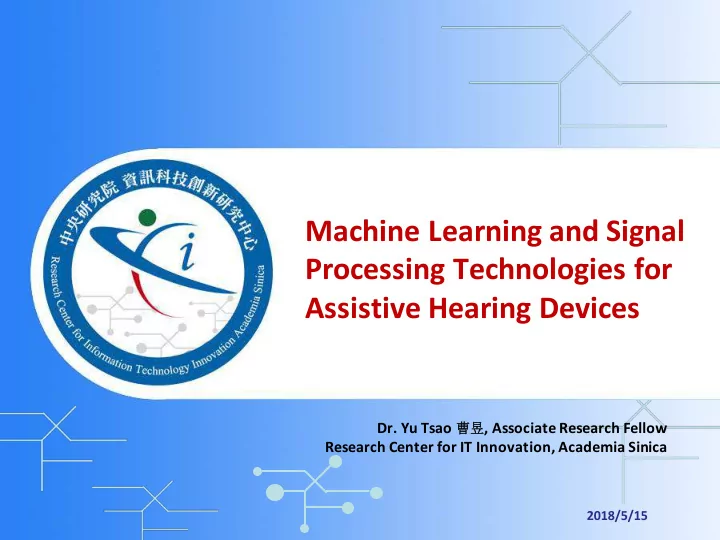

Machine Learning and Signal Processing Technologies for Assistive Hearing Devices Dr. Yu Tsao 曹昱 , Associate Research Fellow Research Center for IT Innovation, Academia Sinica 2018/5/15
Assistive Technology: Assistive Listening and Speaking Devices (by Dr. Yu Tsao) FM system • Conventional FM systems • Smarthear • Two modes of Smarthear Hearing aids • Current issues • Noise reduction (NR) • Amplification scheme (AS) Cochlear implants • Signal processing of CI • Current issues • Noise reduction (NR) 2
Assistive Technology: Assistive Listening and Speaking Devices (by Dr. Yu Tsao) FM system • Conventional FM systems • Smarthear • Two modes of Smarthear Hearing aids • Current issues • Noise reduction (NR) • Amplification scheme (AS) Cochlear implants • Signal processing of CI • Current issues • Noise reduction (NR) 3
Conventional FM System Receiver plus an HA for A direct receiver for Speaker wears individuals with minor microphone and individuals with more hearing loss transmitter severe hearing loss ➢ Speaker and listeners must wear the additional systems ➢ Stigma and inconvenience ➢ High cost: ~ 80,000 NTD ( microphone+ transmitter+ receiver ) Smarthear: smartphone-based FM system
SmartHear 5
SmartHear 2.0 1. 2,500K supported by 科技部 2. 中央社新聞、大愛電視台、中視新聞專訪 3. 臺灣輔具 暨長期照護大展 2017 ATLife 、聽覺毛細 胞至大腦皮層研討會、榮民總醫院聽覺部演講、 輕度聽損輔具研討會 2016 3. IEEE System Journal, IEEE Access, 中華民國專利 4. SmartHear 2.0 (Demo Session) Speech recognition test Hearing test 6
Assistive Technology: Assistive Listening and Speaking Devices (by Dr. Yu Tsao) FM system • Conventional FM systems • Smarthear • Two modes of Smarthear Hearing aids • Current issues • Noise reduction (NR) • Amplification scheme (AS) Cochlear implants • Signal processing of CI • Current issues • Noise reduction (NR) 7
Hearing Aids Only enlarge the volume is not enough! Audiograms Normal hearing Hearing loss 8
A Critical Issue of HA • Kochkin investigated the users’ satisfaction of hearing instrument in United States that the first prevalent requirements was : ➢ 95% of hearing aid user seek the improvement to listen speech in noise. • The hearing-impaired person needs a better signal-to-noise ratio (SNR) than that of a normal- hearing person. • We proposed to use the DL-based noise reduction (NR) methods in digital hearing aids. 9
DL in Speech Signal Processing ➢ X. Lu, Y. Tsao, S. Matsuda and C. Hori, “Speech Enhancement based on Deep Denoising Autoencoder,” Interspeech 2013. 10
Denoising Clean speech Noise: 2baby Crying Noise: Siren Original Noisy MMSE (Trandtional-1) KLT (Trandtional-2) DDAE 2baby Crying Original Noisy MMSE (Trandtional-1) KLT (Trandtional-2) DDAE Siren
De-reverbaration Clean speech Original Noisy DDAE(overall) DDAE(0.3s) IDEL 0.4s Reverberation Original Noisy DDAE(overall) DDAE(0.6s) IDEL 0.7s Reverberation Original Noisy DDAE(overall) DDAE(0.9s) IDEL 1.0s Reverberation
Evaluation Results (Subject Tests) PDNN Clinical trial: 8 CI subjects. 13
Assistive Technology: Assistive Listening and Speaking Devices (by Dr. Yu Tsao) FM system • Conventional FM systems • Smarthear • Two modes of Smarthear Hearing aids • Current issues • Noise reduction (NR) • Amplification scheme (AS) Cochlear implants • Signal processing of CI • Current issues • Noise reduction (NR) 14
Cochlear Implant (CI) • Surgically implanted device that electrically stimulates surviving auditory nerve fibers to provide sound for those with severe hearing loss. • Over 200,000 users worldwide. • FDA approved in 1985, now approved for children as young as 12 months. 15
CI Device Transmitter coil Speech processor: 1. Microphone. 2. DSP chip. 3. Battery 4. Others… 16
CI Device Receiver with stimulating reference electrode and Emitte r Speech Processor
CI Device Traveling wave theory 1961 Von Békésy, Georg (1960). Experiments in hearing. Ed. Ernest Glen Wever. Vol. 8. New York: McGraw-Hill.
Bandpass and Envelope Extraction (A) Waveform of the word “human” spoken by a native American speaker. (B) Spectrogram of the same word. (C) Green lines: Output of a set of six bandpass filters in response to the same word. The filter spacing and bandwidth in this example are two- thirds of an octave.
A Critical Issue of CI • The tremendous progress of CI technologies in the past three decades has enabled many CI users to enjoy high level of speech understanding in quiet . For most CI users, however, the performance of speech • understanding in noise still remains challenging . ➢ F. Chen, Y. Hu, and M. Yuan, “Evaluation of Noise Reduction Methods for Sentence Recognition by Mandarin-Speaking Cochlear Implant Listeners,” Ear and hearing, vol. 36, no. 1, pp. 61-71, 2015. • Deep learning based speech enhancement (SE) for CI. 20
Signal Processing of CI Electric array Transmitter Receiver Speech Microphone processor skin Pulse Band-pass Envelope detection Compression Electrodes generation filter BPF 1 RECT. LPF E 1 COMP. Artificial Neural Network Speech Enhancement Microphone BPF 2 RECT. LPF E 2 COMP. E n LPF BPF n RECT. COMP. 21
DDAE on CI DDAE 22
Vocoded Speech Clean 2T Noise 0dB MMSE DDAE 23
Normal Speech Clean Clean Babble Noise 0dB MMSE DDAE 24
Evaluation Results (Simulations and Subject Tests) Objective evaluation (NCM) Clinical trial: 9 CI subjects. ➢ Y.-H. Lai, F. Chen, S.-S. Wang, X. Lu, Y. Tsao, and C.-H. Lee, "A Deep Denoising Autoencoder Approach to Improving the Intelligibility of Vocoded Speech in Cochlear Implant Simulation," IEEE Transactions on Biomedical Engineering. ➢ Y.-H. Lai, Y. Tsao, X. Lu, F. Chen, Y.-T. Su, K.-C. Chen, Y.-H. Chen, L.-C. Chen, P.-H. Li, and C.-H. Lee, "Deep Learning based Noise Reduction Approach to Improve Speech Intelligibility for Cochlear Implant Recipients,” Ear and Hearing. Vocoder results: 10 normal hearing subjects. 25
Assistive Technology: Assistive Listening and Speaking Devices (by Dr. Yu Tsao) FM system • Conventional FM systems • Smarthear • Two modes of Smarthear Hearing aids • Current issues • Noise reduction (NR) • Amplification scheme (AS) Cochlear implants • Signal processing of CI • Current issues • Noise reduction (NR) 26
Recommend
More recommend